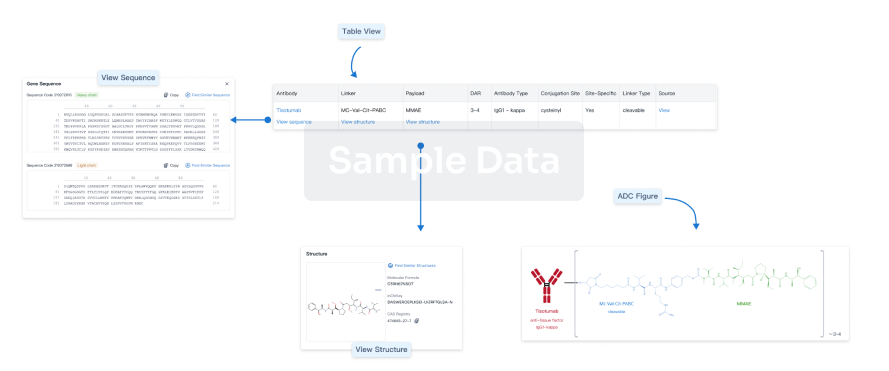Request Demo
Last update 06 Dec 2025
D2C7-based immunotoxins(Istari Oncology, Inc.)
Last update 06 Dec 2025
Overview
Basic Info
Drug Type Antibody toxin conjugate |
Synonyms D2C7-Immunotoxin, D2C7, D2C7 IT + [3] |
Target |
Action antagonists |
Mechanism EGFR antagonists(Epidermal growth factor receptor erbB1 antagonists) |
Therapeutic Areas |
Active Indication |
Inactive Indication- |
Originator Organization |
Active Organization |
Inactive Organization- |
License Organization- |
Drug Highest PhasePhase 1/2 |
First Approval Date- |
Regulation- |
Login to view timeline
Structure/Sequence
Boost your research with our ADC technology data.
login
or

Sequence Code 19691121H

Sequence Code 19691123L

R&D Status
10 top R&D records. to view more data
Login
| Indication | Highest Phase | Country/Location | Organization | Date |
|---|---|---|---|---|
| Glioblastoma Multiforme | Phase 2 | United States | 06 Sep 2023 | |
| Glioblastoma, IDH-Wildtype | Phase 1 | United States | 17 Mar 2025 | |
| Recurrent Glioblastoma | Phase 1 | United States | 17 Mar 2025 | |
| Recurrent Malignant Glioma | Phase 1 | United States | - | 05 May 2015 |
Login to view more data
Clinical Result
Clinical Result
Indication
Phase
Evaluation
View All Results
Phase 2 | Recurrent Glioblastoma IDH wild-type | 18 | D2C7-IT+2141-V11 via CED | kyvvnliwnc(wdozlsbtoi) = grade 1 injection site reaction (n=16) igvifwhspg (fzcplfgunq ) View more | Positive | 11 Nov 2024 | |
NCT04547777 (ASCO2022) Manual | Phase 1 | 8 | cyozmsmxqn(itrpyjalco) = dfaznpavvg hmuvbsnaxs (miytqaxfyz ) | Positive | 02 Jun 2022 | ||
Phase 1 | Recurrent Malignant Glioma EGFR-wt | EGFRvIII | - | qykqnipnth(daupszfalv) = grade III ALT elevation after the first infusion of atezolizumab pkesysocds (jvtrzqrokl ) | - | 09 Nov 2020 | ||
Phase 1 | 43 | ykfbqnqenj(imcrprocua) = grade 4 seizure (n=1) on DL3, grade 3 confusion and pyramidal tract syndrome (n=1) on DL13, and grade 4 cerebral edema (n=1) and grade 3 dysphasia (n=1) on DL17 yuqcbfomfn (crmilutnkh ) View more | Positive | 29 May 2020 | |||
Phase 1/2 | Brain Cancer EGFRwt | EGFRvIII | - | D2C7 immunotoxin | fpjxszgthv(ogjhlkzvoz) = sqayenlttu pssijrapyn (xbymicbdif ) View more | Positive | 01 Mar 2017 |
Login to view more data
Translational Medicine
Boost your research with our translational medicine data.
login
or

Deal
Boost your decision using our deal data.
login
or

Core Patent
Boost your research with our Core Patent data.
login
or

Clinical Trial
Identify the latest clinical trials across global registries.
login
or

Approval
Accelerate your research with the latest regulatory approval information.
login
or

Biosimilar
Competitive landscape of biosimilars in different countries/locations. Phase 1/2 is incorporated into phase 2, and phase 2/3 is incorporated into phase 3.
login
or

Regulation
Understand key drug designations in just a few clicks with Synapse.
login
or

AI Agents Built for Biopharma Breakthroughs
Accelerate discovery. Empower decisions. Transform outcomes.
Get started for free today!
Accelerate Strategic R&D decision making with Synapse, PatSnap’s AI-powered Connected Innovation Intelligence Platform Built for Life Sciences Professionals.
Start your data trial now!
Synapse data is also accessible to external entities via APIs or data packages. Empower better decisions with the latest in pharmaceutical intelligence.
Bio
Bio Sequences Search & Analysis
Sign up for free
Chemical
Chemical Structures Search & Analysis
Sign up for free


